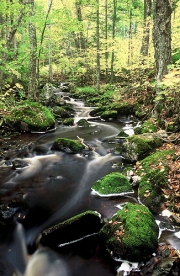
WCS Canada’s Northern Appalachians Transboundary Planning Initiative supports the work of
2C1Forest (Two Countries, One Forest), a network of conservation organizations working collectively to promote transboundary conservation planning in the Northern Appalachian ecoregion. These organizations include conservation NGO's, land trusts, universities and foundations. WCS Canada is helping to achieve the landscape-scale conservation goals of 2C1Forest through active participation in the science committee, executive committee and in collaborative projects.
In particular, WCS Canada has spearheaded the implementation of a fine-scale “
Human Footprint” analysis of the Northern Appalachians region. The “Human Footprint” is part of the “Northern Appalachian Ecological Status and Trends Series” that will help educate and influence policymakers and the public on key issues that are central to ecological integrity in southern Canada and the entire Northern Appalachian region.

The Human Footprint quantifies the accumulated impact of human activities across the region, providing a baseline against which the consequences of development in local areas can be measured. This tool can be used to identify areas with low human impact that can provide low-cost opportunities for conservation action. This methodology can also be use to model trends in human-caused landscape changes as well as the potential impact of proposed development projects in the Northern Appalachians.
The results of the Human Footprint, in combination with the results of other regional science by 2C1Forest collaborators, are providing the information required to build a collective conservation plan for the ecoregion. Together these projects identify intact forest habitat, ecological features of high conservation value, lands that contribute to the connectivity of the ecoregion, present and future threats to the integrity of the landscape.
WCS Canada Researchers:
WCS Canada Partners:
Photo credits: photos provided by the Ecology Action Centre www.ecologyaction.ca